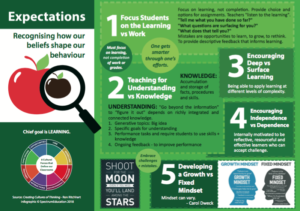The Power of Expectations
“Shoot for the moon and if you miss you’ll land amongst the stars.”  Having great expectations and high standards are proven to help raise achievement in the classroom. Recognising that our beliefs also shape behaviour is a vital key to success.
Having great expectations and high standards are proven to help raise achievement in the classroom. Recognising that our beliefs also shape behaviour is a vital key to success.
In his book, Creating Cultures of Thinking, Ron Ritchhart discusses the role of expectations and outlines five areas to be aware of as a teacher:
1. Focus on the learning, not the work.
Too often, the goal in a classroom seems to be completing the work, getting it finished before the bell, deadline, or next topic starts. Towards the end of the year, it is common to hear teachers celebrating, or lamenting, on how many lessons they have left to complete the teaching of a subject. The challenge in all of this is that just because a student has completed the work, does not mean they have understood or learned it. The chief goal in the classroom must be about the learning. For this to happen, students must able to articulate, firstly, where they are at in the learning journey; secondly, where they are going; and thirdly, to know the steps to get there. Sharing learning progressions is useful in this endeavour. Students must understand the learning process, that learning is about what you don’t know, learning is often challenging and the learning pit is an uncomfortable place to be.
As a teacher, ‘Listen for the learning.’ Ask questions such as, “Tell me what you have done so far.” “What questions do you have?” “What does that tell you?” Avoid questions such as, “What have you done?” or “Are you finished?” Rather, ask, “What have you learned?” Of course the learning may not just be about the content. Learning may include life skills, dispositions, personal awareness and so much more. When focusing on the learning, students must understand that mistakes are opportunities to learn and the word ‘fail’ stands for First Attempt In Learning. Remember to provide feedback to inform learning using clear success criteria.
2. Teach for understanding, not knowledge.
Knowledge is the accumulation and storage of facts, procedures and skills whilst Understanding is going beyond the information given to “figure it out” and depends on richly integrated and connected knowledge.
Ideas to teach for understanding include:
- Designing generative topics with a big idea for students to explore;
- Creating specific goals for understanding;
- Generating performance tasks that require students to use skills and knowledge;
Providing ongoing feedback to improve performance.
3. Encourage deep rather than surface learning.
It is important for students to apply their knowledge at differing levels of complexity and in authentic contexts. Rather than just focusing on memorisation, students are asked to use the knowledge and skills to problem solve and apply their learning to differing contexts. Deep learning includes students being able to ask further and more complex questions, reason a point of view or show connections between ideas.
4. Encourage independence over dependence.
To truly prepare students for life beyond school, they require self directed skills and independence. The goal is for students to be internally motivated to be reflective of their learning and behaviour, resourceful when they are stuck or don’t know what to do and effective learners who can accept challenge. This requires the teacher to slowly ‘let go’ of the control and empower students to be self managing, self monitoring and self modifying.
5. Develop a Growth rather than Fixed Mindset.
Carol Dweck has challenged the underlying beliefs and concepts about learning and intelligence being fixed. She popularised the idea of Growth Mindset, which maintains that when students believe they can get smarter, they understand that effort makes them stronger. As a result, they put in extra time and effort, leading to higher achievement. This requires using the power of ‘yet,’ knowing that if students are finding a task challenging, it does not mean they will never master it; it is just not ‘yet’ mastered and more teaching, learning, and perhaps focus and effort is required. As a teacher, giving specific and measurable feedback on which students can grow and expand upon is critical to encouraging growth mindset. Mindset can vary between students, tasks and even days.
Reflect on these five areas and how you might address these in your classroom as high achievement always takes place in the framework of high expectation. Ron Ritchhart concludes, “It is our expectations of our students, ourselves and the learning process itself that form the foundation of a great classroom culture.”

To download a complimentary copy of this infographic please click here
** This article is the first in a series of 8, focusing on the 8 Cultural Forces and Cultures of Thinking.
Want to know more?
To join the webinar series starting 28th February please go to www.spectrumeducation.com/cultures-of-thinking-webinar-series or contact us for information about the recorded videos from this series.
To purchase and download all 8 posters please go to www.spectrumeducation.com/cultures-of-thinking-infographics/
Tags: Cultural Forces, Cultures of Thinking, Expectations, Karen Boyes, learning, Mindset, Ron Ritchhart
Published on Wednesday, January 24th, 2018, under Cultures of Thinking, Learning
